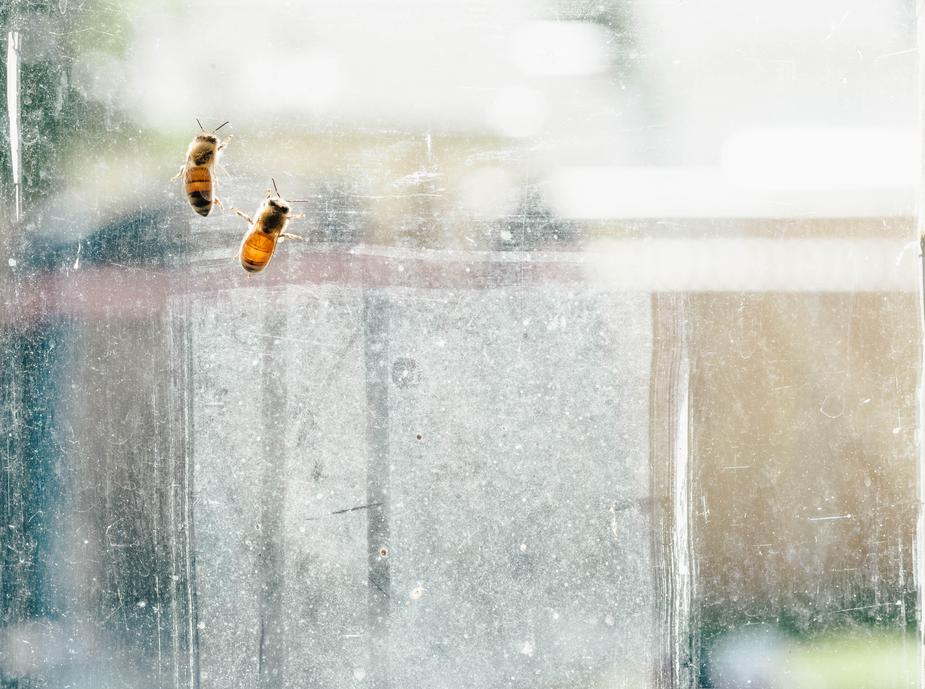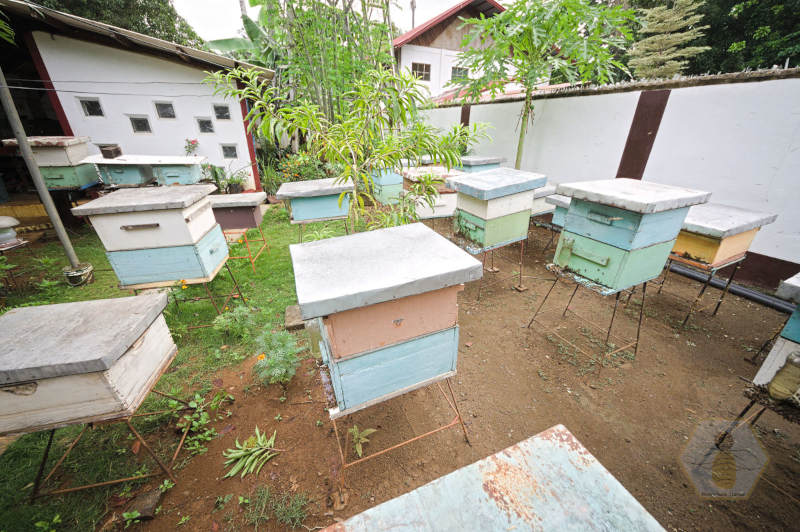Congratulations! You’re one step closer to actually keeping bees of your own. Now, that might not be you. Maybe you’re just looking for the answer to your school paper on honey bees. But when you realize how much space you actually need to keep bees, I hope to spark some genuine interest in beekeeping and honey farming. The community needs you. (Save the Bees – Greenpeace USA)
How much space do you need to keep bees? The longest side of a traditional beehive is 1.58 ft (480 mm) in length. As a beekeeper, you’ll need about 5 feet of space to comfortably move around. That’s a recommended total of 6.58 feet (2.01 meters) on the longest side.
In this article, we’ll explain why that is, how it’s possible to keep bees with even smaller areas such as rooftops, and some best practices to optimize your use of space and earn your neighbors’ acceptance.
Table of Contents
Understanding why small spaces work
If you’re anything like me when I was starting, you’re probably thinking of large acres of farmland housing bees. While it’s true that commercial honey farms are typically found in vast rural areas, the backyard beekeeper is free to house hives in smaller spaces.
Here are some facts about honey bees and why it’s possible.
Bees travel far
Honey bees are capable of traveling as far as 5 miles (8 kilometers) to forage nectar. In fact, it’s been said the combined distance that a colony travels every day is equivalent to the distance from the Earth to the Moon.
(Related: 9 Superhuman Facts About Honey Bees: Trivia with Infographic)
They don’t need the large empty space you’re probably imagining. Most of them fly in circles up and above the hive anyway, before veering out and about. (If they don’t, the beekeeper can introduce some mechanisms to nudge honey bees to fly up. More on this later.)
So if they usually fly up and don’t need much in clear space, then why not just set a space no more than the size of the hive? There are two very important reasons: (1) Bees shoot straight out of the hive and (2) the allotted space is actually for the beekeeper.
Worker bees shoot straight out of the hive
More often than not, honey bees shoot straight out of the exit point like a rocket. This is a reason why beekeepers are advised to approach the hive from the sides.
The little bit of space ensures your bees don’t fly straight to a wall. That said, bees can manage when placed in a literal tight spot such as rooftops. And the crucial reason for the suggested space is really you as a beekeeper.
Space for the beekeeper to work
When you’re managing your bees, you’ll need space to set aside the frames, equipment, and other parts. Working in a very tight space can be frustrating for you and the bees.
Knowing how bees work, it’s clear that the recommended space is really for the beekeeper.
Determining the space you need to keep bees

Now let’s move on to some practical steps you can take in setting up your bee farm, specifically the details you may need to consider when preparing the land and space you’ll need to keep bees.
Step 1: Check if it’s even allowed
Before anything else, you should check if beekeeping is indeed allowed in your area, if special licenses are required, or if any type of beekeeping is prohibited.
The good news is it’s probably legal in your area if you’re not in a densely populated urban area. Not that it’s impractical in urban spaces, because we’ve seen how bees need very little space. But legal concerns may limit your options. When in doubt, it’s always best to contact the state agricultural department or local bee association (if you have one).
Tip: Beekeeping might be lawful in your area, but also check with your neighbors before anything. See the bonus section below for tips on dealing with your neighbors.
Step 2: Know the actual dimensions of your hive
The beginner beekeeper will probably have the Langstroth hive (Wikipedia). If this is you, it should be safe to allocate 19 inches (1.58 ft or 480 mm) in frame length, 9 ⅛ inches in depth, and 1 ⅜ in width.
Robert Engelhardt., CC BY-SA 3.0 http://creativecommons.org/licenses/by-sa/3.0/, via Wikimedia Commons
Using the longest side will allow you more space to move around. So for ease in estimating the space, using the frame’s length should be fine. Otherwise, you may use the precise dimensions of your hive if space is really tight.
Step 3: Choose a location in your backyard or rooftop
Next is to choose a specific place in your backyard or rooftop. Keep in mind the direction of entry and exit points (more on this in the next step), the space you’ll be standing when caring for your bees, and so on.
To recap, allow 6 to 7 feet of space for some leeway.
Step 4: Ensure optimal orientation of entry and exit points
When the hive is set, consider the following when choosing the orientation of your hive’s entry and exit points.
- Do not point the entry and exit points to the house of your neighbor, walkways, or other areas where foot traffic is high. Remember, bees fly straight out. You can avoid unwanted encounters by orienting the entry and exit points in another direction.
- If possible, you may want to consider facing the hive where the sun rises, or slightly south (i.e., southeast). The early sun encourages your bees to start foraging right away.
Step 5: Modify the beehive setup
This final step is multifaceted and ensures a higher chance of success.
- Elevate your hive above the ground so it’s not only away from pests and predators, but also off the damp rain.
- Level the hive from side to side. But also consider tilting the hive slightly with the front barely lower than the rear (about an inch or so), just enough for the water not to collect on the inside.
- A fence encourages your bees to fly above people’s heads. This slight nudge is enough to avoid untimely encounters with neighbors. It also acts as a windbreak against strong winds.
- The hive should ideally be under a sufficient shade as this prevents overheating. If natural shade is unavailable, considering installing one. Comfortable honey bees are less likely to leave.
- Place a water source nearby. Again, comfortable bees are less likely to leave (The water is used to dilute the honey and cool the hive.). Not only is the nearby water source a pleasant amenity for your bees, but it also discourages them from going into the neighbors’ swimming pool or picnic table.
Bonus section on beekeeping space

We can’t have a discussion about how much space you need for beekeeping without talking about your neighbors. Fair or not, the reality is most people have a negative attitude towards bees. But it’s not something we can’t fix with a little bit of effort.
Honey bees are docile insects
Before I knew any better, I always thought of bees as large swarms moving together to blanket the sky. Movies like The Swarm (1978 film) give honey bees a bad rap. Turns out, swarming is a phenomenon that’s disadvantageous to beekeepers, so we do what we can to prevent swarming. (In other words, if your neighbors don’t want to see swarms, having a beekeeper like you is an advantage to them.)
Honey bees are actually very meek little creatures that prefer not to sting. The only time they’re in a stinging mood is when they’re defending the hive. So if you see a honey bee away from the beehive, it’s likely foraging and will ignore you.
It’s also worth saying that most stings are actually from the more aggressive hornets and yellow jackets. The public, unfortunately, sees honey bees and hornets/yellow jackets as one and the same. Some form of education to make this distinction will go a long way. You surely can help.
Gifting works
Gift your neighbors with a basket of honey, candles from beeswax, and similar products. It’s a simple way of showing them the benefits of having bees around. This is also a great time to tell them how honey bees actually are — the docile insects that pollinate a substantial amount of our food and agriculture. (Food and Agriculture Organization on the United Nations)
Conclusion
Backyard beekeeping requires very little space. Honey bees travel great distances for food, and the recommended 6 to 7 feet (around 2 meters) of space at the longest side is really for the beekeeper.
Once you’ve verified the legalities of bee farms in your area, select a space that fits your hive’s dimensions, optimally orient the entry and exit points, modify a few key points such as elevation and water source, and talk to your neighbors about the benefits of honey bees — or even the benefits of having a beekeeper around.
Space isn’t an issue when you have the right mindset. Now go ahead and make something cool, make a difference, start your honey farm.

Honey Farm Starter documents our journey from novices to (hopefully) experts. If you’re feeling a bit intimated by all big words and don’t know where to start, this place is for you. We are Dan & Deanne, and our hope is to create a resource that’s as encouraging as possible for the everyday backyard beekeeper.

